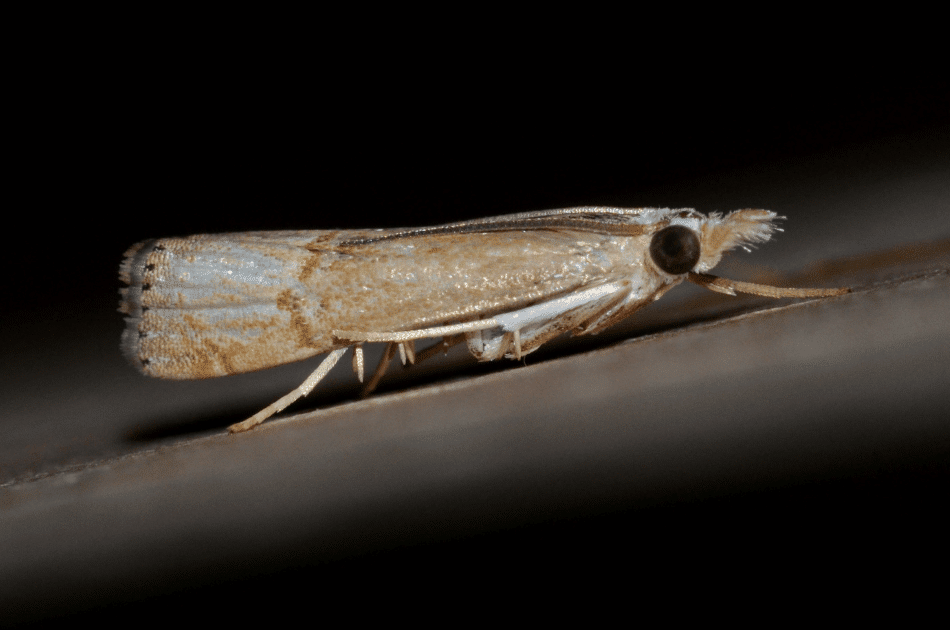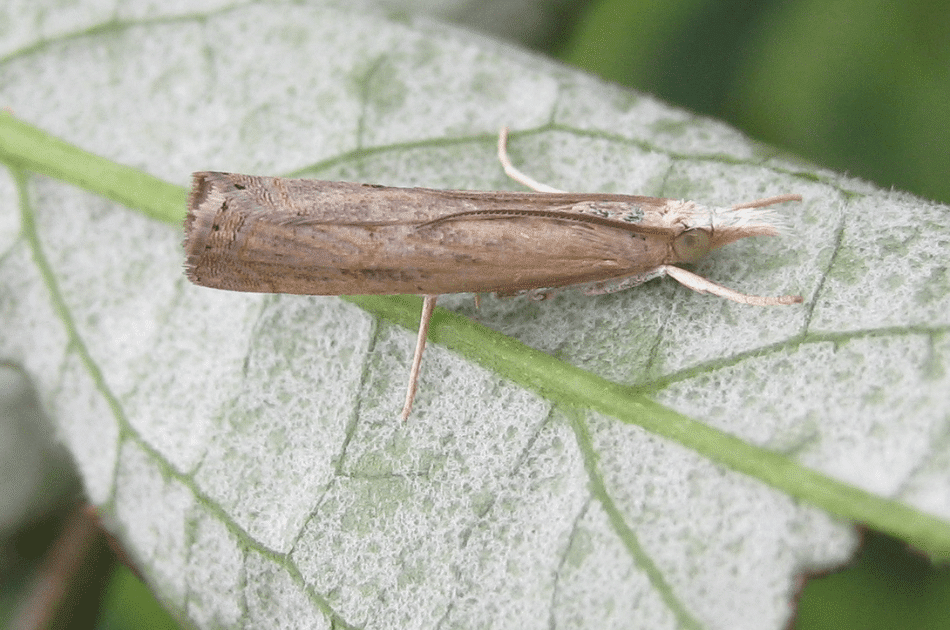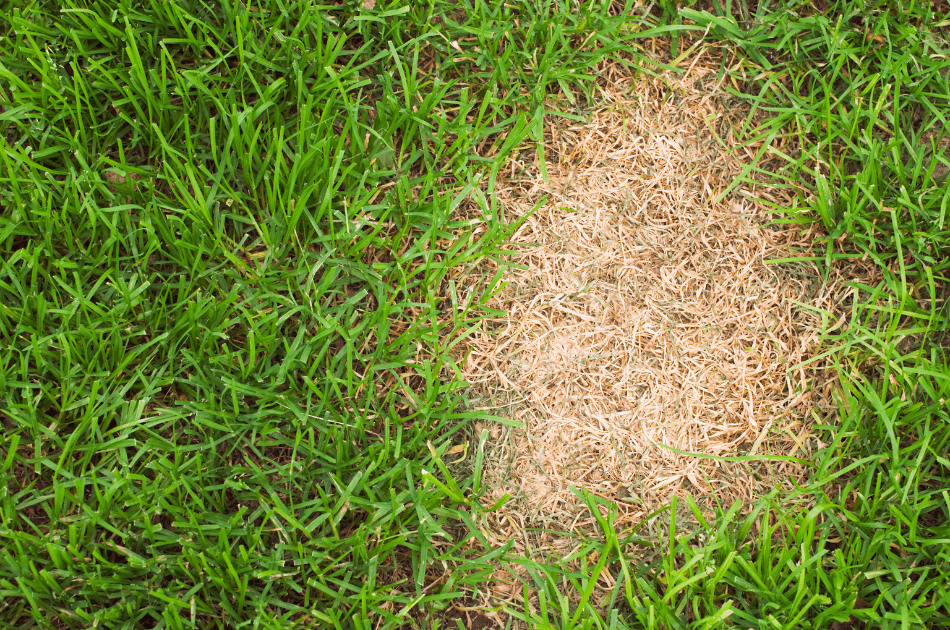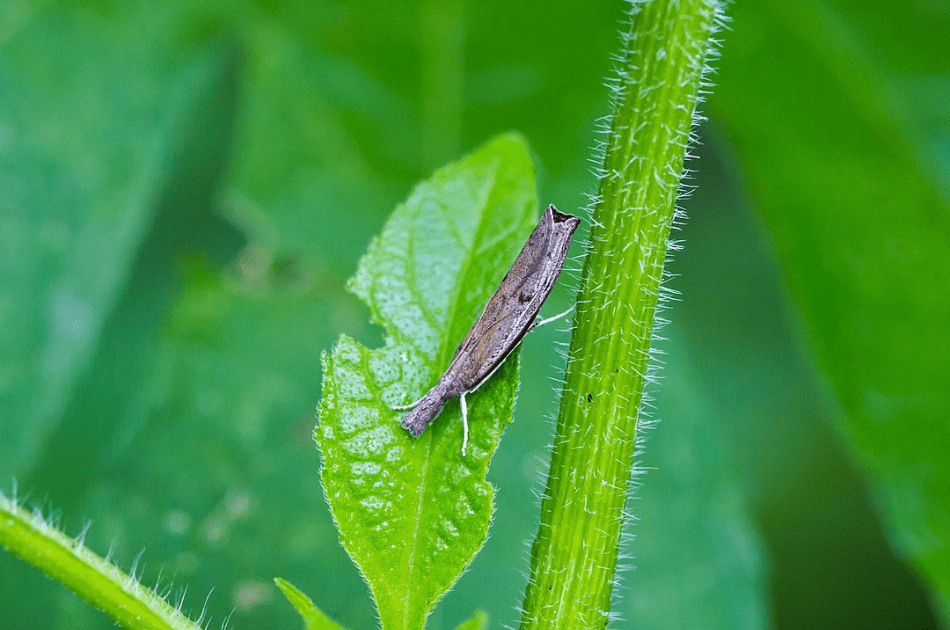Header image courtesy of Katja Schulz from Washington, D. C., USA – Bluegrass Webworm Moth, CC BY 2.0, https://commons.wikimedia.org/w/index.php?curid=67332593
Are you noticing lots of moths near your turfgrass? Or baseball-sized brown patches in your lawn? Both are signs of sod webworms, also known as lawn moths.
The symptoms of sod webworms look almost identical to drought stress, and, in fact, webworms do the most damage when there has been a period of drought.
In this article, we’ll inform you:
- What sod webworms are
- How to differentiate between sod webworm damage and drought stress
- Preventative care and treatment options for sod webworms
- And more
Keep reading to learn more about this lawn pest and how you can keep your lawn green and healthy.

Sod webworm moths tend to be most active at dusk. Image by Andy Reago & Chrissy McClarren – Parapediasia teterrella, CC BY 2.0, https://commons.wikimedia.org/w/index.php?curid=39172116.
What are Sod Webworms?
Sod webworms or lawn moths are pests that are often found in turfgrass in New Jersey and Pennsylvania. Sod webworms get their name from the tunnels constructed of webs in which they reside during the day. Several species of webworms may be found in your lawn, including:
- Silver-striped webworm (Fissicrambus mutabilis)
- Bluegrass sod webworm (Parapediasia teterrella)
- Larger sod webworm (Acrolophus popeanellus)
- Burrowing sod webworm (Acrolophus popeanellus)
The type of webworm isn’t something you’ll need to know, however, as all of them do damage to your lawn.
You may see moths flying over lawns, especially around dusk. If you have also noticed dead patches on your lawn, there’s a good chance that those moths are sod webworms.

A bluegrass webworm moth rests on a leaf. Image by Beatriz Moisset – Own work, CC BY-SA 4.0, https://commons.wikimedia.org/w/index.php?curid=86422425
What do Sod Webworms Look Like?
Sod webworm moths are pale brown, tan, or white in color and have a wingspan of ¾ to 1 inch. The wings wrap around their bodies when not in flight. They have a noticeable “snout,” which is a siphoning mouthpart. They fly in a zig-zag pattern over turfgrass and are attracted to light.
Both the larvae and the moths can cause damage to lawns.
The larvae, which is brown or green and about ¾” long, feed on lawns from July through August, most commonly at night.
Sod webworms overwinter in lawns and reemerge in the spring, so if they are not treated, they will continue to infest your lawn.

How to Recognize Sod Webworm Damage
Like many other lawn issues, sod webworm damage appears as brown patches.
So how can you differentiate sod webworm damage from other lawn pests and diseases?
Sod webworms can do the most damage during times of drought and tend to favor areas that are not as easy to water, such as slopes or banks. As the weather gets warmer and drier, the brown patches can grow and even connect.
Below are some ways to determine if your lawn damage is caused by sod webworms.
Check the color
Lawn damage caused by dogs and sod webworm damage often look similar. One of the main differences is the color of the lawn. Dog urine will turn sections of a yard yellow before it turns brown, but lawns damaged by sod webworm do not turn yellow, only brown.
Examine the border of the brown patch
Larvae of sod webworms chew off the top of leaves and stems. While damage from dogs will leave healthy green grass around the border of the brown section, lawns impacted by sod webworms will show signs of the lawn being eaten or cut.
Search for webs or other signs of pests
The webs themselves can be a clear indication that your lawn has sod webworms. They are small, so may be hard to spot, but a close inspection may reveal some web-lined tunnels.
Webworms also leave small fecal pellets that are green in color. Check the outermost section of brown patches (you may need to move some blades of grass aside) for this tell-tale sign.
Look for holes in the brown patches
The early bird catches the worm, and birds are always on the lookout for a tasty meal. If you notice some small holes in the brown patches, those holes are caused by birds that are searching for webworms.
Test using soap
If the above methods do not help you determine whether your lawn has sod webworms, you can try to force the insect to the surface using soapy water.
According to PennState Extension, simply mix two gallons of water with two tablespoons of liquid dishwashing detergent. Pour the solution over one square yard of impacted turf and wait for the insects to surface. If you notice 10 to 15 larvae in the square yard of turf, treatment may be needed.

A sod webworm moth rests on a green leaf in a New Jersey yard. Image courtesy of Melissa McMasters from Memphis, TN, United States – Changeable grass-veneer, CC BY 2.0, https://commons.wikimedia.org/w/index.php?curid=74527900.
Can Sod Webworms Be Prevented?
One of the best ways to prevent sod webworm is to make sure your lawn receives enough water, especially during periods of drought.
Our organic lawn care services can also keep your turf healthy and prevent lawn pests.
How to Treat Sod Webworms
The best way to get rid of any lawn pest is to keep your lawn healthy. Lawn management can include:
- Maintaining healthy soil
- Regular irrigation
- Proper mowing
- Moderate fertilization when needed
- Encouraging beneficial insects
If you’ve followed all of those steps and still find you have issues with sod webworms, you may need professional lawn treatments to target and destroy the pests. Contact Organic Plant Care to learn about our environmentally friendly lawn treatments and how we can help you treat a sod webworm infestation.
Other Lawn Issues
Sod webworms and other lawn pests can often work together to cause damage to the same lawn. Cinch bugs, for instance, can cause issues during the summer months, and then the moths of sod webworms can appear in late summer or early fall.
Lawns can also be impacted by grubs and other pests and diseases. If you’re not sure what issues may be plaguing your lawn, contact us to schedule a professional assessment.
We Can Help
Sod webworm moths are serious lawn pests that won’t go away on their own. For heavy infestations, you will need professional treatments.
Organic Lawn Care, LLC offers several pest management services for your lawn. We can keep your lawn, as well as your trees and shrubs, healthy and well-maintained year-round, and our Integrated Pest Management methods mean that your property will be a safe and non-toxic environment for everyone who visits.
Contact us today for more information on any of our lawn, tree, or plant treatments or services.
GET THE LATEST NEWS
Subscribe to the Organic Plant Care Newsletter and get timely and helpful tips and updates monthly.
There's no spam - we promise!





